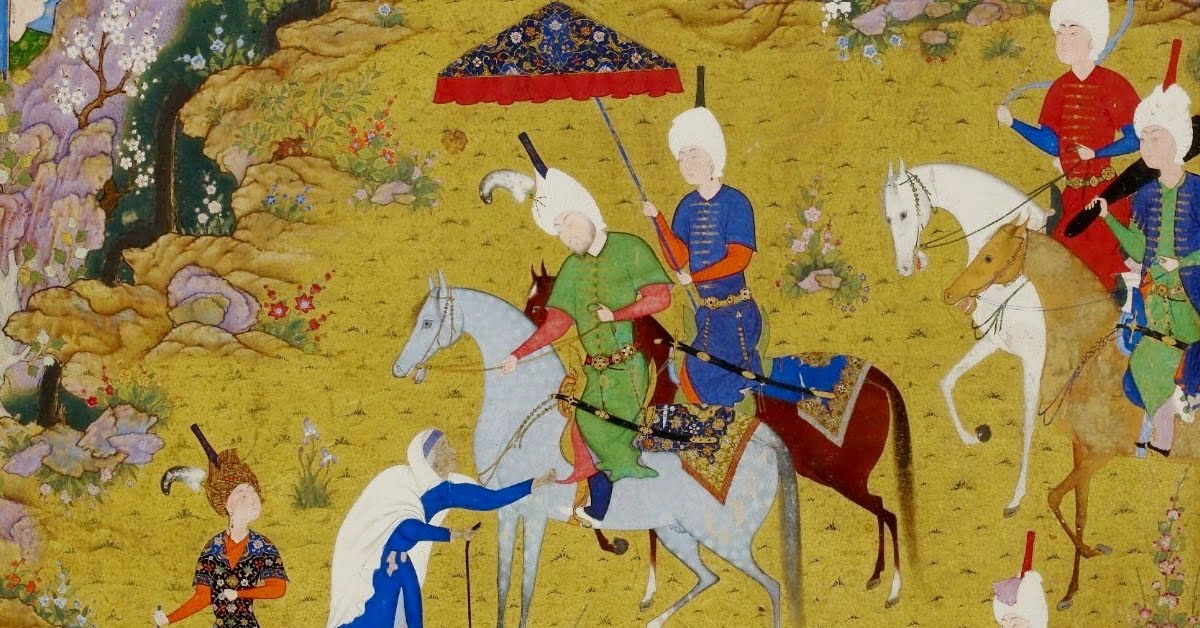It is widely believed that the canons of Islam do not allow the depiction of living beings. We checked if this is true.
You can find it on the Internet materials about full or partial prohibition of images or sculptures of living beings in Islam. Moreover, such information can be found not only on Islamic resources. There is also an argument that calligraphy in the Muslim world received widespread precisely because of the ban on images. Did such a ban really exist in the past or does it exist now?
In order to answer this question, first let us consider the authoritative sources of doctrine existing in the Muslim religious field. The main one of these sources, of course, is Koran - the speech of God sent down to the Prophet Muhammad “in clear Arabic” through an intermediary, the Archangel Gabriel. The Koran contains instructions Sharia — religious law that regulates all aspects of a believer’s life (ritual, social, everyday life, etc.). In the first centuries of Islam, the science of tafsirah - commentaries to the Koran, in which verses of the holy book of Muslims are interpreted both from the point of view of language (syntax, grammar, vocabulary) and from a semantic point of view.
The second source of faith for Muslims is Sunnah, a legend about the life of the Prophet Muhammad, who is a role model for all Muslims. The Sunnah, contrary to popular belief, is not one single text. It is installed on the basis hadiths - stories about Muhammad that meet certain conditions, which describe his actions, statements and so-called tacit approvals. A separate branch of Muslim religious sciences is devoted to the main body of hadith, which uses an extensive system of classifying messages about Muhammad and identifying the most reliable of them. Such hadiths (they are classified as "sahih" - “faithful”) were collected separately, and the six most authoritative collections of hadiths “sahih” were called "Six Books".
The Koran and Sunnah are the main, but not the only sources for a fuqaha, a specialist in Muslim law (fiqh). A jurist not only makes decisions on the basis of the Qur'an and Sunnah, he also uses various rational methods and from time to time must resort to his own judgment. Differences in the definition of methods and sources of fiqh, as well as the preference of some methods over others, at one time gave rise to the development of madhhabs - schools of Islamic law. At the moment, the most widespread in the world are four schools of Sunni law (Malikis, Shafiites, Hanafis and Hanbalites), as well as the Jafarite madhhab, the adherents of which are the majority of the Shiites of the world.
An important difference between Islam and, for example, Christianity is that in Islam there is no single center of authority. In Islam, the institution of a church headed by a person with unshakable authority among believers has not developed. Similarly, in Islam there is no clergy in its Christian sense, but in the 8th–9th centuries a class of religious scholars, known in Russian as ulema, developed there. It was the representatives of this corporation who became those who, in the absence of a single center of authority and a clear hierarchy, acquired the right to interpret and interpret the principles of the Koran and Sunnah. In other words, in the Muslim world there does not exist and cannot exist a person whose powers or status will be at least to some extent similar to the powers and status of the Pope or Patriarch. At the same time, this situation leads to the existence of a wide field of interpretation and a large number of authorities. Mufti - an authoritative specialist who has the right to make theological and legal decisions (fatwa), makes decisions, the execution of which is theoretically prescribed only to his followers.
An important story about images in the Koran is the story of the prophet Ibrahim (biblical Abraham), who condemns their relatives because they worship images: “He said to his father and his people: “What are these images that you worship?”” They object to him that they are doing this because their fathers did so. However, Ibrahim calls them to believe in one God and destroys idols (Quran 21:51–58). This story does not directly imply that images or statues are unacceptable - it condemns the worship of images, which in Muslim doctrine is classified as "shirk" The concept of “shirk” is translated as “giving partners to God,” that is, worshiping something else besides God (for example, from an Islamic point of view, the category of “shirk” includes the veneration of the Trinity by Christians).
Another story often cited as an argument for the ban is the account of the gods worshiped by the people of the prophet Nuh (the biblical Noah). The Koran reports that people turned away from the message of Nuh and continued to worship the previous deities: “Do not abandon your gods, do not abandon Wadd, and Suwa, and Yagus, and Yauk, and Nasr!” (Quran 71:23). This story is revealed in hadiths. The authoritative collection of al-Bukhari (810–870) provides a commentary by the prophet on this verse, which states that these names previously belonged to the righteous, and then Shaitan advised people to create statues in the places where these righteous people sat.
Both of these texts, as we see, do not contain a direct prohibition on the creation of images. They only talk about the inadmissibility of worshiping images. At the same time, starting from the 9th century, there has been an increase in interpretations of the story of Ibrahim and specifically verse 21:52 as indicating the prohibition of images and statues. However, such an instruction is not at all a dogma that must be followed. In particular, tafsir Saadi, popular among Russian Muslims interprets This is like a warning against polytheism - it is unacceptable to worship statues and images.
If we turn to the corpus of hadiths, then among those recognized as reliable one can find a number of messages devoted to Muhammad’s attitude towards images. Quite often a hadith is quoted that angels will not enter a house that contains images or a dog. However, authoritative hadith collectors give different versions of this message. So, one version talks about the permissibility of patterns on fabric. A popular theme in hadiths about images and statues is a warning to their creators. Such messages say that the creators of the images will be subjected to terrible torment in hell. In another hadith, this idea is revealed - the artist will have to breathe life into his creation. Such judgments are explained by the fact that the creator of the images encroaches on the functions of God - the source of all created things.
In a number of hadiths one can find arguments in favor of the admissibility of images. In one of these reportedthat the prophet tore the curtain with images in the room of his wife Aisha, but she later made pillowcases from this fabric for the pillows on which Muhammad sat. Another hadith, the transmitter and one of the characters of which is also Aisha, talks about her dolls (the prophet married Aisha when she was still a child). In one version of this message described toy - a horse with wings. When Muhammad asked Aisha whether there were horses with wings, she answered him that the prophet Suleiman (biblical Solomon) had such. In response to this, Muhammad laughed, which can be regarded as approval. In another version of this hadith explainedthat Aisha was allowed to play with dolls since she was still a child.
Such hadiths can be interpreted in different ways. Is the prophet’s laughter in response to Aisha’s remark an endorsement of images and statues in general, or are we talking only about children’s toys? Is it possible to depict animals only on pillows or can this judgment be interpreted more broadly? The hadith quoted above about angels not entering the house of images, for example, has a longer version in which it says about the inadmissibility of anthropomorphic images. The Prophet explains that one can create images that resemble trees or cut off heads that resemble living creatures. In such cases, much depends on the nature of the interpretation - whether it will be strictly literal or broader.
Researcher Christiane Gruber, speaking out on the narrower topic of the admissibility of images of Muhammad, notes that in the historical body of fatwas there is not a single decision that would explicitly and strictly prohibit images and statues. Prohibitions of this level are already in online collections of fatwas. For example, a fatwa banning images was issued by the Taliban in 2001, who tried to justify their plans to destruction Buddha statues in Bamiyan. By the way, a number of Muslim countries and individual authoritative muftis performed strongly against such a decision.
The diverse culture of the Muslim world has produced images and statues over the centuries: for example, in the manuscript tradition stayed rich iconography ascension Prophet Muhammad and other episodes from his life. Christian Gruber in his article highlights two periods in the history of images of Muhammad. She notes that in images from the 13th–15th centuries one can see the face of the prophet without any veils, which appear in miniatures from the 16th–19th centuries. The researcher also claims that similar curtains or calligraphic figures hiding the face of Muhammad could have been added later, which should reflect more conservative religious trends.
In modern Iran meets a large number of different images of Muhammad. There you can also see many monuments to poets (for example, Ferdowsi) or modern heroes like the deceased IRGC general Qassem Soleimani (there is also his bust in Lebanon). In addition, over the last century, a large number of photographic and video materials of a utilitarian (for example, passport photos and driver's license), informational or entertainment nature (television, cinema, etc.) have appeared in Muslim countries. It is unlikely that all this would have been possible under the notorious ban on images.
The key problem that arises even from a superficial study of the case with images is that there are many points of view on this matter, supported by the established system of authority in Islam. While some muftis may, for example, authorize photographs and television (as happened throughout the 19th and 20th centuries), others (as in the case of the Taliban and the Bamiyan statues) may issue bans on the use of images. Sources of authority in the form of the Koran and Sunnah, as we see, provide both possibilities, and the absence of a certain church hierarchy only reinforces such pluralism. The second point that I would like to note in connection with the current situation is the politicization of artistic practices themselves. The most serious scandals with tragic consequences arose around cartoons of the Prophet Muhammad in newspapers Jyllands-Posten And Charlie Hebdo. The discussion around such scandals no longer revolves around the acceptability/inadmissibility of images in general, but the offensiveness of a particular image in particular.
Half-truth
Read on topic:
2. Was it always forbidden to depict the Prophet Muhammad?
3. Muslims have visualized Prophet Muhammad in words and calligraphic art for centuries
If you find a spelling or grammatical error, please let us know by highlighting the error text and clicking Ctrl+Enter.







